Dongfu Jiang
ACECODER: Acing Coder RL via Automated Test-Case Synthesis
Feb 03, 2025Abstract:Most progress in recent coder models has been driven by supervised fine-tuning (SFT), while the potential of reinforcement learning (RL) remains largely unexplored, primarily due to the lack of reliable reward data/model in the code domain. In this paper, we address this challenge by leveraging automated large-scale test-case synthesis to enhance code model training. Specifically, we design a pipeline that generates extensive (question, test-cases) pairs from existing code data. Using these test cases, we construct preference pairs based on pass rates over sampled programs to train reward models with Bradley-Terry loss. It shows an average of 10-point improvement for Llama-3.1-8B-Ins and 5-point improvement for Qwen2.5-Coder-7B-Ins through best-of-32 sampling, making the 7B model on par with 236B DeepSeek-V2.5. Furthermore, we conduct reinforcement learning with both reward models and test-case pass rewards, leading to consistent improvements across HumanEval, MBPP, BigCodeBench, and LiveCodeBench (V4). Notably, we follow the R1-style training to start from Qwen2.5-Coder-base directly and show that our RL training can improve model on HumanEval-plus by over 25\% and MBPP-plus by 6\% for merely 80 optimization steps. We believe our results highlight the huge potential of reinforcement learning in coder models.
MEGA-Bench: Scaling Multimodal Evaluation to over 500 Real-World Tasks
Oct 14, 2024



Abstract:We present MEGA-Bench, an evaluation suite that scales multimodal evaluation to over 500 real-world tasks, to address the highly heterogeneous daily use cases of end users. Our objective is to optimize for a set of high-quality data samples that cover a highly diverse and rich set of multimodal tasks, while enabling cost-effective and accurate model evaluation. In particular, we collected 505 realistic tasks encompassing over 8,000 samples from 16 expert annotators to extensively cover the multimodal task space. Instead of unifying these problems into standard multi-choice questions (like MMMU, MMBench, and MMT-Bench), we embrace a wide range of output formats like numbers, phrases, code, \LaTeX, coordinates, JSON, free-form, etc. To accommodate these formats, we developed over 40 metrics to evaluate these tasks. Unlike existing benchmarks, MEGA-Bench offers a fine-grained capability report across multiple dimensions (e.g., application, input type, output format, skill), allowing users to interact with and visualize model capabilities in depth. We evaluate a wide variety of frontier vision-language models on MEGA-Bench to understand their capabilities across these dimensions.
VideoScore: Building Automatic Metrics to Simulate Fine-grained Human Feedback for Video Generation
Jun 24, 2024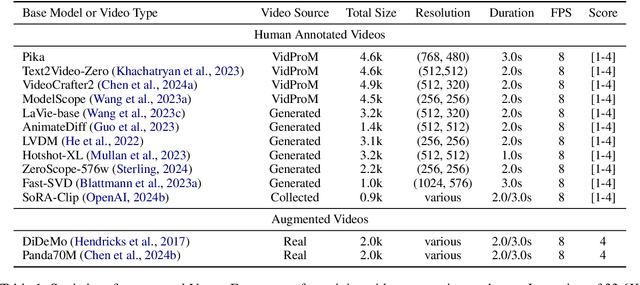

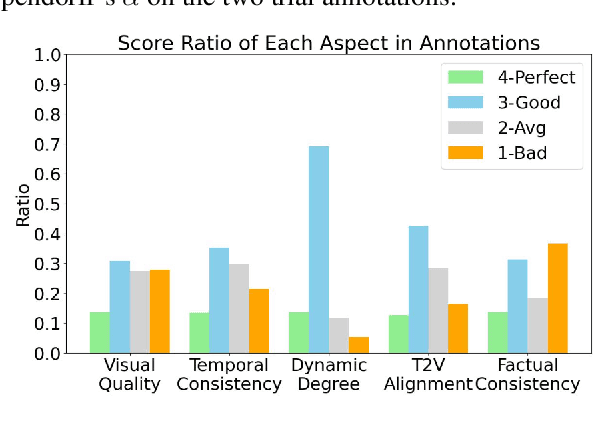

Abstract:The recent years have witnessed great advances in video generation. However, the development of automatic video metrics is lagging significantly behind. None of the existing metric is able to provide reliable scores over generated videos. The main barrier is the lack of large-scale human-annotated dataset. In this paper, we release VideoFeedback, the first large-scale dataset containing human-provided multi-aspect score over 37.6K synthesized videos from 11 existing video generative models. We train VideoScore (initialized from Mantis) based on VideoFeedback to enable automatic video quality assessment. Experiments show that the Spearman correlation between VideoScore and humans can reach 77.1 on VideoFeedback-test, beating the prior best metrics by about 50 points. Further result on other held-out EvalCrafter, GenAI-Bench, and VBench show that VideoScore has consistently much higher correlation with human judges than other metrics. Due to these results, we believe VideoScore can serve as a great proxy for human raters to (1) rate different video models to track progress (2) simulate fine-grained human feedback in Reinforcement Learning with Human Feedback (RLHF) to improve current video generation models.
WildVision: Evaluating Vision-Language Models in the Wild with Human Preferences
Jun 16, 2024Abstract:Recent breakthroughs in vision-language models (VLMs) emphasize the necessity of benchmarking human preferences in real-world multimodal interactions. To address this gap, we launched WildVision-Arena (WV-Arena), an online platform that collects human preferences to evaluate VLMs. We curated WV-Bench by selecting 500 high-quality samples from 8,000 user submissions in WV-Arena. WV-Bench uses GPT-4 as the judge to compare each VLM with Claude-3-Sonnet, achieving a Spearman correlation of 0.94 with the WV-Arena Elo. This significantly outperforms other benchmarks like MMVet, MMMU, and MMStar. Our comprehensive analysis of 20K real-world interactions reveals important insights into the failure cases of top-performing VLMs. For example, we find that although GPT-4V surpasses many other models like Reka-Flash, Opus, and Yi-VL-Plus in simple visual recognition and reasoning tasks, it still faces challenges with subtle contextual cues, spatial reasoning, visual imagination, and expert domain knowledge. Additionally, current VLMs exhibit issues with hallucinations and safety when intentionally provoked. We are releasing our chat and feedback data to further advance research in the field of VLMs.
GenAI Arena: An Open Evaluation Platform for Generative Models
Jun 06, 2024Abstract:Generative AI has made remarkable strides to revolutionize fields such as image and video generation. These advancements are driven by innovative algorithms, architecture, and data. However, the rapid proliferation of generative models has highlighted a critical gap: the absence of trustworthy evaluation metrics. Current automatic assessments such as FID, CLIP, FVD, etc often fail to capture the nuanced quality and user satisfaction associated with generative outputs. This paper proposes an open platform GenAI-Arena to evaluate different image and video generative models, where users can actively participate in evaluating these models. By leveraging collective user feedback and votes, GenAI-Arena aims to provide a more democratic and accurate measure of model performance. It covers three arenas for text-to-image generation, text-to-video generation, and image editing respectively. Currently, we cover a total of 27 open-source generative models. GenAI-Arena has been operating for four months, amassing over 6000 votes from the community. We describe our platform, analyze the data, and explain the statistical methods for ranking the models. To further promote the research in building model-based evaluation metrics, we release a cleaned version of our preference data for the three tasks, namely GenAI-Bench. We prompt the existing multi-modal models like Gemini, GPT-4o to mimic human voting. We compute the correlation between model voting with human voting to understand their judging abilities. Our results show existing multimodal models are still lagging in assessing the generated visual content, even the best model GPT-4o only achieves a Pearson correlation of 0.22 in the quality subscore, and behaves like random guessing in others.
MANTIS: Interleaved Multi-Image Instruction Tuning
May 02, 2024



Abstract:The recent years have witnessed a great array of large multimodal models (LMMs) to effectively solve single-image vision language tasks. However, their abilities to solve multi-image visual language tasks is yet to be improved. The existing multi-image LMMs (e.g. OpenFlamingo, Emu, Idefics, etc) mostly gain their multi-image ability through pre-training on hundreds of millions of noisy interleaved image-text data from web, which is neither efficient nor effective. In this paper, we aim at building strong multi-image LMMs via instruction tuning with academic-level resources. Therefore, we meticulously construct Mantis-Instruct containing 721K instances from 14 multi-image datasets. We design Mantis-Instruct to cover different multi-image skills like co-reference, reasoning, comparing, temporal understanding. We combine Mantis-Instruct with several single-image visual-language datasets to train our model Mantis to handle any interleaved image-text inputs. We evaluate the trained Mantis on five multi-image benchmarks and eight single-image benchmarks. Though only requiring academic-level resources (i.e. 36 hours on 16xA100-40G), Mantis-8B can achieve state-of-the-art performance on all the multi-image benchmarks and beats the existing best multi-image LMM Idefics2-8B by an average of 9 absolute points. We observe that Mantis performs equivalently well on the held-in and held-out evaluation benchmarks. We further evaluate Mantis on single-image benchmarks and demonstrate that Mantis can maintain a strong single-image performance on par with CogVLM and Emu2. Our results are particularly encouraging as it shows that low-cost instruction tuning is indeed much more effective than intensive pre-training in terms of building multi-image LMMs.
VIEScore: Towards Explainable Metrics for Conditional Image Synthesis Evaluation
Dec 22, 2023



Abstract:In the rapidly advancing field of conditional image generation research, challenges such as limited explainability lie in effectively evaluating the performance and capabilities of various models. This paper introduces VIESCORE, a Visual Instruction-guided Explainable metric for evaluating any conditional image generation tasks. VIESCORE leverages general knowledge from Multimodal Large Language Models (MLLMs) as the backbone and does not require training or fine-tuning. We evaluate VIESCORE on seven prominent tasks in conditional image tasks and found: (1) VIESCORE (GPT4-v) achieves a high Spearman correlation of 0.3 with human evaluations, while the human-to-human correlation is 0.45. (2) VIESCORE (with open-source MLLM) is significantly weaker than GPT-4v in evaluating synthetic images. (3) VIESCORE achieves a correlation on par with human ratings in the generation tasks but struggles in editing tasks. With these results, we believe VIESCORE shows its great potential to replace human judges in evaluating image synthesis tasks.
MMMU: A Massive Multi-discipline Multimodal Understanding and Reasoning Benchmark for Expert AGI
Nov 27, 2023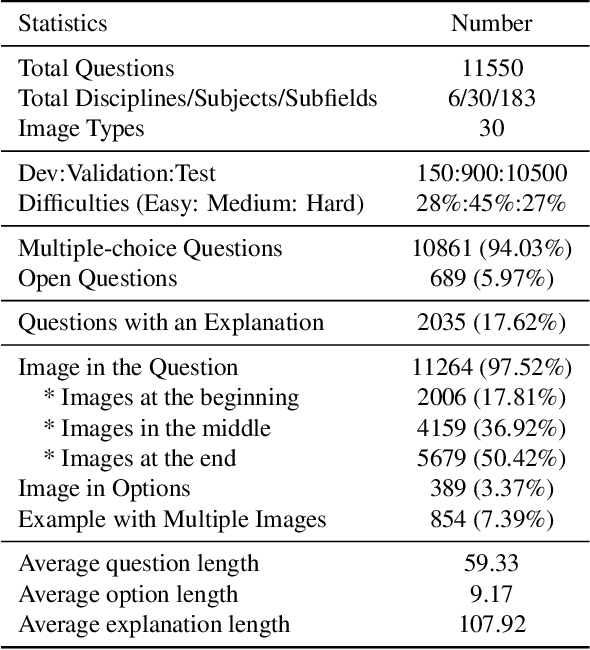
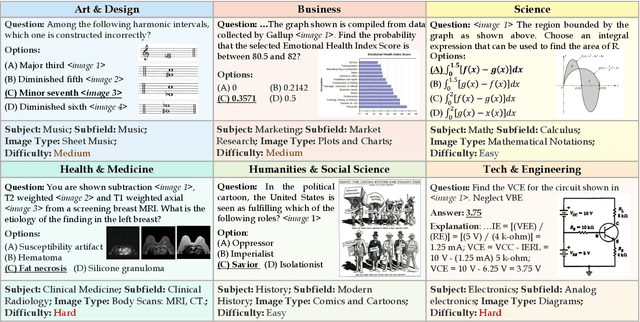
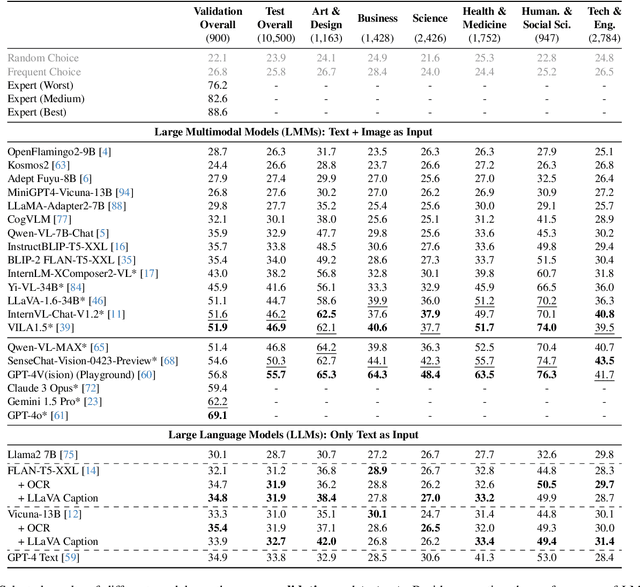

Abstract:We introduce MMMU: a new benchmark designed to evaluate multimodal models on massive multi-discipline tasks demanding college-level subject knowledge and deliberate reasoning. MMMU includes 11.5K meticulously collected multimodal questions from college exams, quizzes, and textbooks, covering six core disciplines: Art & Design, Business, Science, Health & Medicine, Humanities & Social Science, and Tech & Engineering. These questions span 30 subjects and 183 subfields, comprising 30 highly heterogeneous image types, such as charts, diagrams, maps, tables, music sheets, and chemical structures. Unlike existing benchmarks, MMMU focuses on advanced perception and reasoning with domain-specific knowledge, challenging models to perform tasks akin to those faced by experts. Our evaluation of 14 open-source LMMs and the proprietary GPT-4V(ision) highlights the substantial challenges posed by MMMU. Even the advanced GPT-4V only achieves a 56% accuracy, indicating significant room for improvement. We believe MMMU will stimulate the community to build next-generation multimodal foundation models towards expert artificial general intelligence.
TIGERScore: Towards Building Explainable Metric for All Text Generation Tasks
Oct 01, 2023Abstract:We present TIGERScore, a \textbf{T}rained metric that follows \textbf{I}nstruction \textbf{G}uidance to perform \textbf{E}xplainable, and \textbf{R}eference-free evaluation over a wide spectrum of text generation tasks. Different from other automatic evaluation methods that only provide arcane scores, TIGERScore is guided by the natural language instruction to provide error analysis to pinpoint the mistakes in the generated text. Our metric is based on LLaMA, trained on our meticulously curated instruction-tuning dataset MetricInstruct which covers 6 text generation tasks and 23 text generation datasets. The dataset consists of 48K quadruple in the form of (instruction, input, system output $\rightarrow$ error analysis). We collected the `system outputs' through diverse channels to cover different types of errors. To quantitatively assess our metric, we evaluate its correlation with human ratings on 5 held-in datasets, 2 held-out datasets and show that TIGERScore can achieve the highest overall Spearman's correlation with human ratings across these datasets and outperforms other metrics significantly. As a reference-free metric, its correlation can even surpass the best existing reference-based metrics. To further qualitatively assess the rationale generated by our metric, we conduct human evaluation on the generated explanations and found that the explanations are 70.8\% accurate. Through these experimental results, we believe TIGERScore demonstrates the possibility of building universal explainable metrics to evaluate any text generation task.
LLM-Blender: Ensembling Large Language Models with Pairwise Ranking and Generative Fusion
Jun 10, 2023Abstract:We present LLM-Blender, an ensembling framework designed to attain consistently superior performance by leveraging the diverse strengths of multiple open-source large language models (LLMs). Our framework consists of two modules: PairRanker and GenFuser, addressing the observation that optimal LLMs for different examples can significantly vary. PairRanker employs a specialized pairwise comparison method to distinguish subtle differences between candidate outputs. It jointly encodes the input text and a pair of candidates, using cross-attention encoders to determine the superior one. Our results demonstrate that PairRanker exhibits the highest correlation with ChatGPT-based ranking. Then, GenFuser aims to merge the top-ranked candidates, generating an improved output by capitalizing on their strengths and mitigating their weaknesses. To facilitate large-scale evaluation, we introduce a benchmark dataset, MixInstruct, which is a mixture of multiple instruction datasets featuring oracle pairwise comparisons. Our LLM-Blender significantly outperform individual LLMs and baseline methods across various metrics, establishing a substantial performance gap.
 Add to Chrome
Add to Chrome Add to Firefox
Add to Firefox Add to Edge
Add to Edge